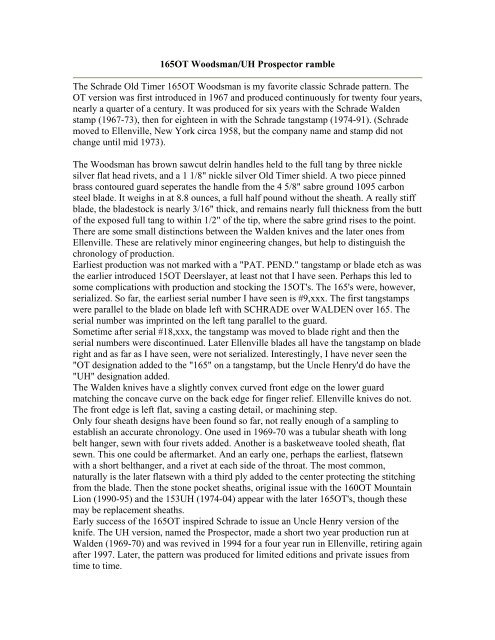165OT Woodsman/UH Prospector ramble - Collectors-of-Schrades ...
165OT Woodsman/UH Prospector ramble - Collectors-of-Schrades ...
165OT Woodsman/UH Prospector ramble - Collectors-of-Schrades ...
Create successful ePaper yourself
Turn your PDF publications into a flip-book with our unique Google optimized e-Paper software.
<strong>165OT</strong> <strong>Woodsman</strong>/<strong>UH</strong> <strong>Prospector</strong> <strong>ramble</strong><br />
The Schrade Old Timer <strong>165OT</strong> <strong>Woodsman</strong> is my favorite classic Schrade pattern. The<br />
OT version was first introduced in 1967 and produced continuously for twenty four years,<br />
nearly a quarter <strong>of</strong> a century. It was produced for six years with the Schrade Walden<br />
stamp (1967-73), then for eighteen in with the Schrade tangstamp (1974-91). (Schrade<br />
moved to Ellenville, New York circa 1958, but the company name and stamp did not<br />
change until mid 1973).<br />
The <strong>Woodsman</strong> has brown sawcut delrin handles held to the full tang by three nickle<br />
silver flat head rivets, and a 1 1/8" nickle silver Old Timer shield. A two piece pinned<br />
brass contoured guard seperates the handle from the 4 5/8" sabre ground 1095 carbon<br />
steel blade. It weighs in at 8.8 ounces, a full half pound without the sheath. A really stiff<br />
blade, the bladestock is nearly 3/16" thick, and remains nearly full thickness from the butt<br />
<strong>of</strong> the exposed full tang to within 1/2" <strong>of</strong> the tip, where the sabre grind rises to the point.<br />
There are some small distinctions between the Walden knives and the later ones from<br />
Ellenville. These are relatively minor engineering changes, but help to distinguish the<br />
chronology <strong>of</strong> production.<br />
Earliest production was not marked with a "PAT. PEND." tangstamp or blade etch as was<br />
the earlier introduced 15OT Deerslayer, at least not that I have seen. Perhaps this led to<br />
some complications with production and stocking the 15OT's. The 165's were, however,<br />
serialized. So far, the earliest serial number I have seen is #9,xxx. The first tangstamps<br />
were parallel to the blade on blade left with SCHRADE over WALDEN over 165. The<br />
serial number was imprinted on the left tang parallel to the guard.<br />
Sometime after serial #18,xxx, the tangstamp was moved to blade right and then the<br />
serial numbers were discontinued. Later Ellenville blades all have the tangstamp on blade<br />
right and as far as I have seen, were not serialized. Interestingly, I have never seen the<br />
"OT designation added to the "165" on a tangstamp, but the Uncle Henry'd do have the<br />
"<strong>UH</strong>" designation added.<br />
The Walden knives have a slightly convex curved front edge on the lower guard<br />
matching the concave curve on the back edge for finger relief. Ellenville knives do not.<br />
The front edge is left flat, saving a casting detail, or machining step.<br />
Only four sheath designs have been found so far, not really enough <strong>of</strong> a sampling to<br />
establish an accurate chronology. One used in 1969-70 was a tubular sheath with long<br />
belt hanger, sewn with four rivets added. Another is a basketweave tooled sheath, flat<br />
sewn. This one could be aftermarket. And an early one, perhaps the earliest, flatsewn<br />
with a short belthanger, and a rivet at each side <strong>of</strong> the throat. The most common,<br />
naturally is the later flatsewn with a third ply added to the center protecting the stitching<br />
from the blade. Then the stone pocket sheaths, original issue with the 160OT Mountain<br />
Lion (1990-95) and the 153<strong>UH</strong> (1974-04) appear with the later <strong>165OT</strong>'s, though these<br />
may be replacement sheaths.<br />
Early success <strong>of</strong> the <strong>165OT</strong> inspired Schrade to issue an Uncle Henry version <strong>of</strong> the<br />
knife. The <strong>UH</strong> version, named the <strong>Prospector</strong>, made a short two year production run at<br />
Walden (1969-70) and was revived in 1994 for a four year run in Ellenville, retiring again<br />
after 1997. Later, the pattern was produced for limited editions and private issues from<br />
time to time.
The differences between the first and second issue knives are minor. One unique feature<br />
does stand out on the Walden issue, besides the obvious tangstamps and serial numbers.<br />
The top <strong>of</strong> the tang has eight thumb rest grooves.<br />
Other than the thumb rest grooves on the first issue, the 165<strong>UH</strong> bore all <strong>of</strong> the trademark<br />
features <strong>of</strong> it's Old Timer brother with the following exceptions. Staglon replaced the<br />
sawcut delrin, the shield was brass with the Uncle Henry signature the handle rivets were<br />
brass, and the <strong>UH</strong> designation was added to the 165 tangstamp.<br />
My own interest in these knives, though discontinued ten years now and made by a<br />
company no longer existing, began more than thirty years ago when I purchased one for<br />
my hunting and camping adventures. The serpentine handle and heft have become so<br />
familiar that it is difficult to use and carry another pattern. The blade sweep is etched in<br />
my memory so that I can use it in near total darkness without loosing blood. I'll continue<br />
my quest to dig out obscure facts and details on the 165's. Not that anyone cares, but I<br />
find it personally interesting.<br />
Any corrections and additions to this missive are expected and most welcomed!<br />
Codger


